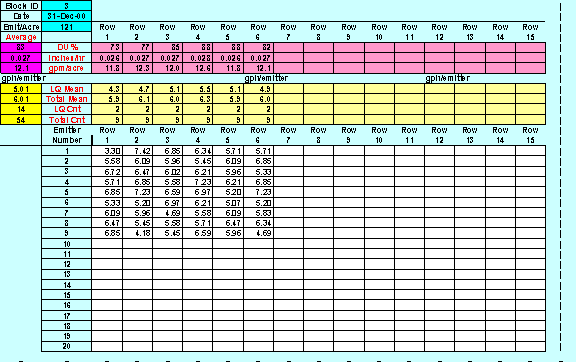User’s Guide for
IS004 Quick Answer
R. L. Snyder, Biometeorology Specialist
Department of Land, Air and Water Resources
University of California
Davis, CA 95616, USA
N.V. O’Connell, Farm Advisor
UCCE Tulare County
Ag Bldg Co Civic Ctr
Visalia, CA 93291, USA
Copyright – Regents of the University of California
Created – July 2000
Last Revision –July 2001
Entering Data
DU is an Excel program for calculating distribution uniformity and the mean application rate of drip and micro-sprinkler irrigation systems. The companion program ‘DUm’ is the metric version of the same program. To obtain a copy, click on DU for the English unit version or DUm for the metric unit version. To use the DU or DUm programs, you must collect some data from the irrigation system that you are trying to evaluate. Then enter the following information into the ‘Input’ worksheet. In cells B2 and B3, enter a block number and the date for record keeping. The flow rates from the emitters can be made in ounces or in milliliters for a pre-selected rate of time. Enter the measurement time interval in seconds into cell G2. Based on experience, a measurement time interval of 15 seconds works well for typical micro-sprinklers used for citrus. In the cell below, enter either “O” for measurements in ounces or “M” for measurements in milliliters (cell G3). In the cell G3, enter the number of emitters per acre for the DU program. Enter the emitters per hectare in the DUm program. Then enter the measured flow rates into the table in cells B7 through P26. Row (hose) numbers are listed across the top and emitter numbers are given along the left-hand side. Entering the data in the correct order helps to identify problem emitters in your system. A sample entry table for a system with 121 emitters per acre (299 emitters per hectare) is shown below. Sample flow rates in milliliters per 15 seconds were entered for nine emitters on each of six hoses (rows). The flow rate in milliliters per 15 seconds would also be entered into the DUm (metric) program. Note again that the flow rate can also be input in ounces per 15 seconds if ‘O’ rather than ‘M’ is input for the volume measurement in the DU program.

Results
The worksheet named “Output” contains the results of the calculations. The emitter flow rates, converted to gallons per hour per emitter, are shown in the main body of the sample table below. The total number of samples, the number of low quarter samples, the overall mean flow rate (gph per emitter), and the mean of the low quarter are shown above the sample flow rate data for each row (hose of emitters). The results for all of the emitters, are shown in column A. Above the flow rate data, the distribution uniformity percentage (DU%) and mean application rates in inches per hour and gpm per acre are provided. The overall mean DU% and application rates are given in column A.

Collecting Flow Data
The schematic below shows the laterals and hoses for a typical system. Flow measurements should be taken from a minimum of about 20 emitters. Be sure to measure the flow from emitters from hoses at both the upper and lower end of the lateral. Take one measurement near the riser and one near the end of each hose. Collect at least two measurements equally spaced between the riser and the end.
